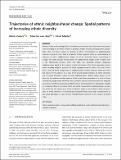Files in this item
Trajectories of ethnic neighbourhood change : spatial patterns of increasing ethnic diversity
Item metadata
| dc.contributor.author | Zwiers, Merle | |
| dc.contributor.author | van Ham, Maarten | |
| dc.contributor.author | Manley, David | |
| dc.date.accessioned | 2017-11-06T13:30:15Z | |
| dc.date.available | 2017-11-06T13:30:15Z | |
| dc.date.issued | 2018-03 | |
| dc.identifier.citation | Zwiers , M , van Ham , M & Manley , D 2018 , ' Trajectories of ethnic neighbourhood change : spatial patterns of increasing ethnic diversity ' , Population, Space and Place , vol. 24 , no. 2 , e2094 . https://doi.org/10.1002/psp.2094 | en |
| dc.identifier.issn | 1544-8452 | |
| dc.identifier.other | PURE: 251478677 | |
| dc.identifier.other | PURE UUID: adb3d8ee-fc46-4b54-bb2f-ed58a03b4f12 | |
| dc.identifier.other | Bibtex: urn:454a297fb431421c281f20400af93433 | |
| dc.identifier.other | Scopus: 85043288410 | |
| dc.identifier.other | ORCID: /0000-0002-2106-0702/work/64697581 | |
| dc.identifier.other | WOS: 000426747300012 | |
| dc.identifier.uri | https://hdl.handle.net/10023/12004 | |
| dc.description | European Research Council under the European Union's Seventh Framework Program; ERC Grant Agreement, Grant/Award Number: 615159 (ERC Consolidator Grant DEPRIVEDHOODS, Socio‐spatial inequality, deprived neighbourhoods, and neighbourhood effects); Marie Curie program under the European Union's Seventh Framework Program; Career Integration, Grant/Award Number: PCIG10‐GA‐2011‐303728 (CIG Grant NBHCHOICE, Neighbourhood choice, neighbourhood sorting, and neighbourhood effects) | en |
| dc.description.abstract | Western cities are increasingly ethnically diverse, and in most cities, the share of the population belonging to an ethnic minority is growing. Studies analysing changing ethnic geographies often limit their analysis to changes in ethnic concentrations in neighbourhoods between 2 points in time. Such a temporally limited approach limits our understanding of pathways of ethnic neighbourhood change and of the underlying factors contributing to change. This paper analyses full trajectories of neighbourhood change in the 4 largest cities in the Netherlands between 1999 and 2013. Our modelling strategy categorises neighbourhoods based on their unique growth trajectories of the ethnic population composition, providing insight in processes of ethnic segregation and its drivers. Our main conclusion is that the ethnic composition in neighbourhoods remains relatively stable over time. We however find evidence for a slow trend towards deconcentration of ethnic minorities and increased population mixing in most neighbourhoods. Spatial mixing appears to be driven by the selective mobility patterns of the native Dutch population as a result of urban restructuring programmes. However, these pathways towards deconcentration are mitigated by processes of ethnic natural growth that reinforce existing patterns of segregation. Despite an increasing inflow of the native Dutch into ethnic concentration neighbourhoods, segregation at the top and bottom ends of the distribution seems to be persistent: High concentrations of ethnic minorities in disadvantaged neighbourhoods versus high concentrations of the native population in more affluent neighbourhoods continue to be a feature of Dutch cities. | |
| dc.language.iso | eng | |
| dc.relation.ispartof | Population, Space and Place | en |
| dc.rights | Copyright © 2017 The Authors. Population, Space and Place published by John Wiley & Sons Ltd. This is an open access article under the terms of the Creative Commons Attribution License, which permits use, distribution and reproduction in any medium, provided the original work is properly cited. | en |
| dc.subject | Ethnic segregation | en |
| dc.subject | Latent class growth modelling | en |
| dc.subject | Longitudinal study | en |
| dc.subject | Neighbourhood trajectories | en |
| dc.subject | Population dynamics | en |
| dc.subject | G Geography (General) | en |
| dc.subject | 3rd-NDAS | en |
| dc.subject.lcc | G1 | en |
| dc.title | Trajectories of ethnic neighbourhood change : spatial patterns of increasing ethnic diversity | en |
| dc.type | Journal article | en |
| dc.contributor.sponsor | European Research Council | en |
| dc.description.version | Publisher PDF | en |
| dc.contributor.institution | University of St Andrews. School of Geography & Sustainable Development | en |
| dc.identifier.doi | https://doi.org/10.1002/psp.2094 | |
| dc.description.status | Peer reviewed | en |
| dc.identifier.grantnumber | ERC-2013-CoG | en |
This item appears in the following Collection(s)
Items in the St Andrews Research Repository are protected by copyright, with all rights reserved, unless otherwise indicated.

